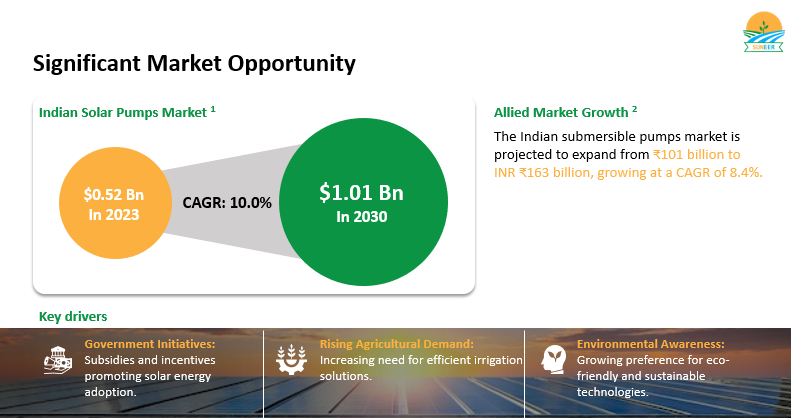The Indian solar pumps market has become a pivotal sector in transforming the country’s agricultural and water management practices. As both environmental and economic concerns grow, solar pumps offer a sustainable, cost-effective, and reliable solution. The projections of market growth from $0.52 billion in 2023 to $1.01 billion in 2030, with a CAGR of 10.0%, underscore the immense opportunities this industry presents. Let’s delve deeper into the broader implications of this growth and how it will shape the future of agriculture and water sustainability.

Why Solar Pumps Are the Ideal Solution for India
India’s economy is deeply tied to its agriculture sector, which contributes nearly 20% of the GDP and employs almost half of the workforce. However, irrigation in many parts of the country still depends on inefficient, costly, and environmentally damaging diesel or electric pumps. Solar pumps offer a revolutionary alternative with multiple benefits:
- Energy Independence for Farmers:
Solar-powered pumps allow farmers to operate independently of unreliable electricity grids or expensive diesel fuel. This independence helps reduce irrigation costs and increases productivity. - Addressing Water Scarcity:
India faces significant water challenges, with many regions suffering from acute water shortages. Solar pumps enable efficient groundwater extraction, ensuring water availability in arid and semi-arid regions. - Reducing Carbon Footprints:
Solar pumps are powered by renewable energy, which reduces greenhouse gas emissions. For every solar pump installed, the dependency on fossil fuels is reduced, aligning with India’s commitment to achieving net zero emissions by 2070. - Low Maintenance and Long Lifespan:
Modern solar pumps require minimal maintenance compared to their diesel counterparts. With fewer moving parts and no reliance on fuel, they are more durable and cost-effective in the long term.
Driving Forces Behind the Growth
Several trends and policies have converged to create an ecosystem where solar pumps thrive. Here’s a closer look at the primary drivers:
- Government-Led Push for Renewable Energy:
The Indian government has introduced several schemes and subsidies to promote solar pump adoption. PM-KUSUM, for instance, has set a target of installing 3.5 million solar pumps across India by 2024. This program provides up to 60% financial assistance to farmers, significantly reducing the cost burden. - Technological Advancements in Solar Energy:
Continuous innovation in solar panel efficiency and battery storage systems has made solar pumps more reliable and affordable. The integration of smart technologies, such as IoT-based monitoring and automation, further enhances their usability and performance. - Private Sector Involvement:
Companies like SuNeer are leveraging advanced technologies and partnering with government bodies to provide tailored solutions for farmers. Their focus on product durability, affordability, and serviceability has made them key players in this growing market. - Rising Awareness Among Farmers:
Farmers are becoming increasingly aware of the long-term economic and environmental benefits of solar pumps. Educational campaigns and demonstration projects have played a crucial role in building trust and accelerating adoption. - Complementary Growth in Submersible Pumps Market:
The Indian submersible pumps market, projected to grow from INR ₹101 billion to ₹163 billion by 2030, complements the solar pump industry. The integration of submersible technology with solar power systems is creating efficient solutions for irrigation and water management, further driving market expansion.
Environmental and Economic Impacts of Solar Pumps
The widespread adoption of solar pumps can generate significant environmental and economic benefits for India:
- Reduction in Fuel Dependency:
India imports a significant portion of its fuel needs. By transitioning to solar pumps, the country can reduce its diesel consumption, saving foreign exchange and improving energy security. - Employment Generation:
The solar pump industry is creating jobs in manufacturing, installation, maintenance, and distribution, particularly in rural areas. This contributes to overall rural development and economic empowerment. - Sustainable Agriculture:
Solar pumps promote sustainable irrigation practices by enabling farmers to irrigate their fields during daytime hours when sunlight is abundant. This reduces water wastage and ensures optimal crop growth.
Challenges to Overcome
While the growth outlook is promising, several challenges need to be addressed to unlock the full potential of the solar pump market:
- High Initial Costs:
Despite government subsidies, the upfront cost of solar pumps can still be a barrier for small and marginal farmers. Expanding financing options and improving access to loans is crucial. - Awareness Gaps:
Many farmers are unaware of the financial incentives and long-term benefits of solar pumps. Effective awareness campaigns and training programs are essential. - Operation in Low Sunlight Conditions:
Solar pumps rely on sunlight, which can be a limitation during cloudy days or in regions with low solar irradiance. Advancements in energy storage solutions, like solar batteries, can mitigate this issue. - Infrastructure and Supply Chain:
Ensuring the availability of spare parts and after-sales services in rural areas remains a challenge. Building robust supply chains and local service networks is critical for sustaining growth.
Future Trends and Innovations
The future of the solar pump industry will be shaped by technological advancements and innovative business models. Some anticipated trends include:
- Hybrid Systems: Combining solar pumps with traditional power sources or wind energy for consistent performance.
- Decentralized Solar Farms: Installing solar pumps connected to decentralized solar farms for group usage, benefiting small-scale farmers.
- IoT Integration: Smart solar pumps with IoT-based sensors for real-time monitoring, water usage optimization, and predictive maintenance.
Conclusion: Unlocking India’s Solar Pump Potential
The solar pump market represents a critical intersection of agriculture, renewable energy, and water management. With a growth trajectory fueled by government policies, private sector innovation, and increasing awareness, solar pumps are poised to revolutionize India’s irrigation landscape.
By overcoming current challenges and leveraging emerging technologies, India can not only improve agricultural productivity but also set a global example in sustainable water management. The expansion of solar pumps is more than a market opportunity—it’s a step toward achieving energy independence, reducing environmental impacts, and empowering rural communities.

